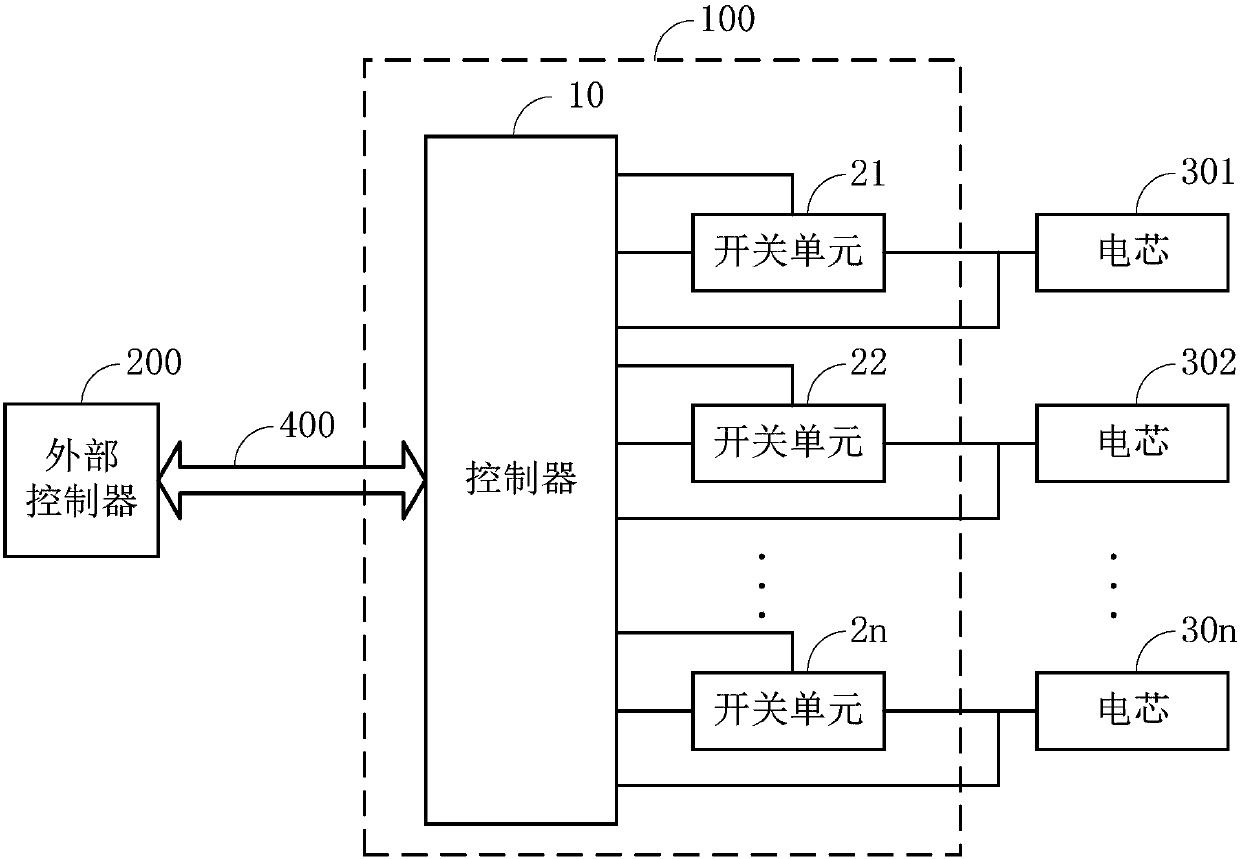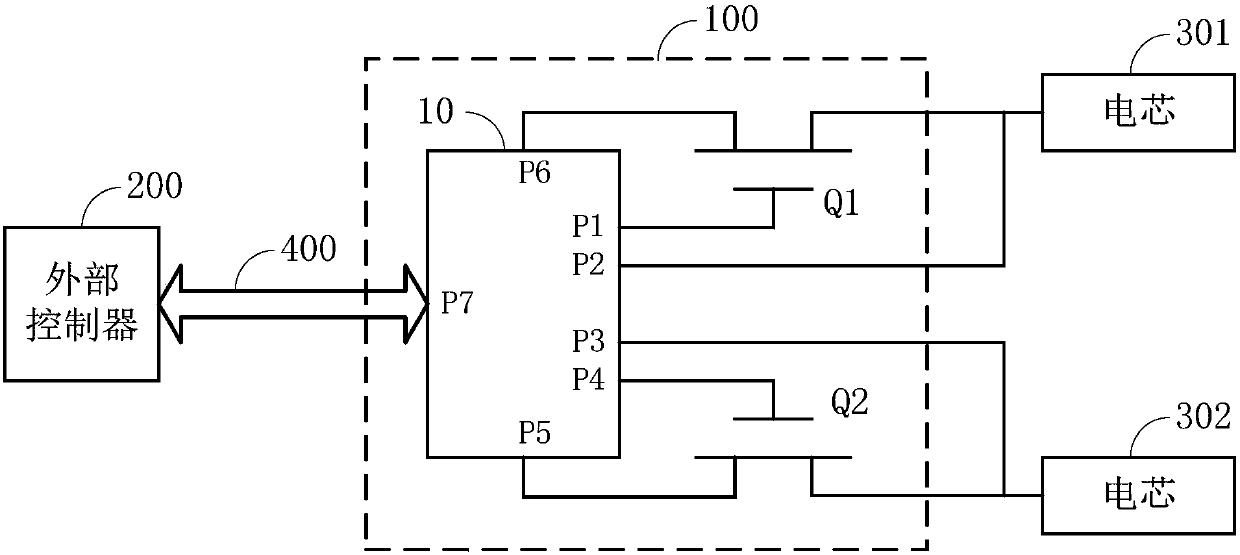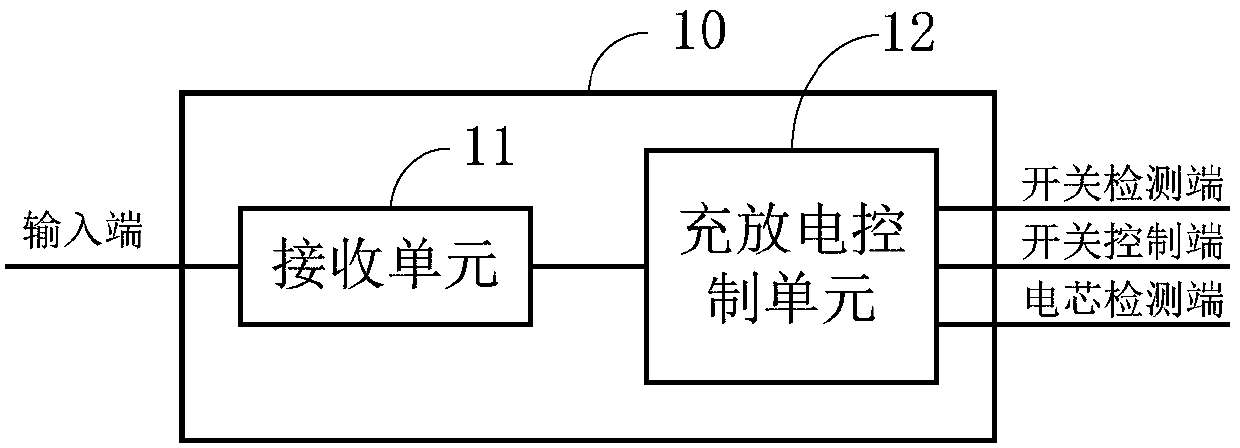A control circuit and terminal of a battery cell
A technology for controlling circuits and battery cells, applied in the field of electronics, can solve the problems of shortening the service life of batteries, aging of cells, and inability to solve the problems of mutual charging of cells, so as to prolong the service life and prevent mutual charging.
- Summary
- Abstract
- Description
- Claims
- Application Information
AI Technical Summary
Problems solved by technology
Method used
Image
Examples
Embodiment 1
[0023] Such as figure 1 As shown, the battery cell control circuit 100 provided in this embodiment includes a controller 10 and at least two switch units 21-2n (the switch units 21-2n refer to the switch unit 21 and the switch unit 22 , ..., switch unit 2n).
[0024] The input end of the controller 10 is connected to the external controller 200 through the communication bus 400;
[0025] Each of the at least two switch units 21-2n is correspondingly connected to a cell, the controlled end of each switch unit is correspondingly connected to a control end of the controller 10, and the input of each switch unit Both terminals are connected to a switch detection terminal of the controller 10, and the output terminals of each switch unit are connected to a battery detection terminal of the controller 10 together with the input terminal of the corresponding battery cell;
[0026] If the controller 10 receives the charging notification output by the external controller 200, the con...
Embodiment 2
[0035] In this embodiment, on the basis of Embodiment 1, the switch units 21-2n are limited to MOS transistors. When the switch units 21-2n are N-type MOS transistors, the gates, sources and drains of the N-type MOS transistors respectively constitute the controlled end, input end and output end of the switch unit; when the switch units 21-2n are P-type MOS transistors, the gate, source and drain of the P-type MOS transistor respectively constitute the switch The slave, output, and input of the unit.
[0036] In this embodiment, the structure of the control circuit 100 is specifically described by taking the control circuit 100 including two MOS transistor switch units as an example:
[0037] Such as figure 2 As shown, the control circuit 100 includes a controller 10, a MOS transistor Q1 and a MOS transistor Q2, the MOS transistor Q1 is correspondingly connected to the battery cell 301, and the MOS transistor Q2 is correspondingly connected to the battery cell 302;
[0038]...
Embodiment 3
[0046] Such as image 3 As shown, this embodiment is a further refinement of the controller 10 in Embodiment 1. In this embodiment, the controller 10 includes:
[0047] a receiving unit 11, configured to receive the charging notification output by the external controller;
[0048] A charging and discharging control unit 12, configured to control at least one of the switching units to be turned on if the receiving unit 11 receives the charging notification, to charge the batteries correspondingly connected to at least one of the switching units;
[0049] The receiving unit 11 is also used to receive the discharge notification output by the external controller 200;
[0050] The charge and discharge control unit 12 is also used to control at least two switch units 21-2n to turn on sequentially if the receiving unit 11 receives the discharge notification, and when one of the switch units is turned on, the other switch units are all turned off, so that at least two At least two bat...
PUM
 Login to View More
Login to View More Abstract
Description
Claims
Application Information
 Login to View More
Login to View More - R&D Engineer
- R&D Manager
- IP Professional
- Industry Leading Data Capabilities
- Powerful AI technology
- Patent DNA Extraction
Browse by: Latest US Patents, China's latest patents, Technical Efficacy Thesaurus, Application Domain, Technology Topic, Popular Technical Reports.
© 2024 PatSnap. All rights reserved.Legal|Privacy policy|Modern Slavery Act Transparency Statement|Sitemap|About US| Contact US: help@patsnap.com










